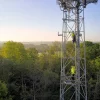Gov Commits Gigabit Broadband for All England Schools by 2025

The Government’s Education Secretary, Nadhim Zahawi MP, has today made a new commitment for “every school across the country” to be able to access “high speed internet” by 2025, which is said to complement the wider £5bn Project Gigabit broadband rollout programme. Funding will also be provided for related WiFi upgrades.
On top of this, the Government has also announced a £150m fund to “support schools most in need to upgrade their WiFi connections“. Over the course of the next three years, the Department for Education (DfE) said they would reach out to schools in priority areas to facilitate the introduction of faster and more reliable connectivity.
The funding mentioned above will include those in the DfE’s previously identified Education Investment Areas. “These 55 areas were first set out in the Levelling Up White Paper in February this year and refer to areas of the country where school outcomes are the weakest,” said the government.
Advertisement
Overall, it’s a good commitment, although we’re confused as to why they would commit to something as vague as “high speed internet by 2025“, while at the same time only referencing “gigabit broadband” more generally in the announcement (i.e. not directly alongside the 2025 date). We fear this could leave room for slower connectivity options to meet the related eligibility criteria, and we’re currently trying to clarify this.
Nadhim Zahawi, Education Secretary, said:
“Digital technology, and the data and infrastructure that underpins it, is changing the way we live, work, and learn. We need to use our experience from the pandemic as a springboard to embed new and better ways of using technology in schools, and across education.
This new investment moves us a giant step forward to helping ensure that every school across the country has the best technology.
Upgrading schools to high speed broadband, setting out clear standards so that schools know what technology they should have in place, as well as providing funding to support them in achieving this, is the latest way we are levelling up education across the country.”
At this point it’s worth remembering that the government, through its earlier Local Full Fibre Networks (LFFN) programme, voucher schemes and related follow-on programmes, has been working to extend gigabit-capable broadband connections (mostly via full fibre links) to UK schools since 2019. As a result of that, around 2,000 additional schools – at a cost of c.£50m – in rural and semi-rural areas are expected to have already benefitted (here).
However, data released last November by the UK Government’s Department for Digital, Culture, Media and Sport (DCMS) indicated that 3,835 UK schools were still in postcodes “that do not have access” to full fibre broadband connectivity “or are currently not in areas of proposed commercial build within the next five years” (here).
The above figure gives some indication of the remaining problem area, although it should be said that they didn’t factor in other forms of gigabit-capable connectivity, such as via Virgin Media’s Hybrid Fibre Coax (HFC) network or leased lines. Some schools do make use of such methods, although these are admittedly much more common in urban environments.
Advertisement
Mark is a professional technology writer, IT consultant and computer engineer from Dorset (England), he also founded ISPreview in 1999 and enjoys analysing the latest telecoms and broadband developments. Find me on X (Twitter), Mastodon, Facebook, BlueSky, Threads.net and Linkedin.
« Vodafone Explains Why Some FTTP Areas Only Offered 200Mbps





















































Bodger’s Circus is all promise no delivery.
I thought both parties promised FTTP for the whole country by 2025? Why now just schools? And it seems odd why they are being so cagey on even offering that.
The FTTP for all by 2025 commitment was watered down long ago to 85% via “gigabit-capable” technologies, due to being totally undeliverable in such a timescale. Bit of history:
https://www.ispreview.co.uk/index.php/2019/09/government-to-water-down-2025-full-fibre-for-all-uk-target-become-gigabit.html
https://www.ispreview.co.uk/index.php/2020/11/government-start-5bn-uk-gigabit-broadband-rollout-for-85.html
https://www.ispreview.co.uk/index.php/2021/11/gov-targets-universal-uk-gigabit-broadband-coverage-for-2030.html
Get some more blood money in from Abu Dhabi and City Fibre will do it…
Money genuinely isn’t the problem for CityFibre now, though nice leveraging of ‘blood money’ into the equation.
Ever been to Abu Dhabi? It’s a very interesting place. Recommend it, gives some perspective. I couldn’t live there but have more of an understanding of why things are as they are.
I assume you’ve never used an Uber taxi anywhere in the world then?
https://www.hrw.org/world-report/2021/country-chapters/united-arab-emirates
Worth reading this. I have no desire to go to a country that treats it’s citizens like this.
And wrt to Uber – even if I had, how does that make it ok. Two wrongs don’t make a right.
And plenty of stuff wrong in YouKay as well:
https://www.hrw.org/world-report/2021/country-chapters/united-kingdom
Perhaps we should look at closer at home first before criticizing other regimes?
Hopefully this is restricted to state schools? I’d hate to be subsidising private, fee paying schools as these should be expected to pay their own way.
You don’t subsidise private schools.
My kids are both at state school in England – and as such the school receives around £6,700 per pupil for their education.
Every kid at private school saves the government £6,700 plus the cost of underwriting teachers pensions + the capital cost of buildings etc – quite easily £10-£12k a year per pupil.
The “private schools are subsidised” comments typically overlook this and focus on the relatively low level of charitable relief – despite the fact the overall saving to the Government is much greater.
Don’t trust the Tories
Don’t vote for them then, Phil.
yet in thr Rural North we find B4RN supplying the schools with 10 gigabit connections and in the case of the small primaries they get the service completely free too. It isn’t difficult.Every school in the B4RN area gets a connection. If a small altnet can do it from scratch, why can’t an incumbent with existing ducts, poles and wayleaves?
Something to do with B4RN covering 10,000-odd premises alongside having extensive community assistance and the incumbent over 30 million at a wild guess.
Please stop with the comparing of your fantastic non-profit with commercial operators, it belittles what B4RN have achieved.
If it isn’t difficult, why are there still not-spot schools in Cumbria that B4RN haven’t stepped-up to resolve?
How many UK schools have the ‘incumbent’ connected in comparison? Can you substantiate your rantings?
Your lazy approach to mud-slinging rather than just celebrating your own success makes you a very poor ambassador for B4RN.
I mean ‘free’ is a bit of a stretch, all of their build projects are entirely reliant on subsidy. They’re doing great work, but it’s disingenuous to make out that they are self-funding these connections.
Although the Government keeps changing targets it is good to see that they recognise the importance of fast broadband for schools. I guess that in the end they will achieve it although the path meanders rather a lot. I think @MarkJackson has documented those meanders rather well.
Small rural primary schools are particularly needy of fast broadband (symmetrical) as they often lack staff and resources to meet the full educational needs of their pupils. Collaboration with other primaries, secondary’s and their LEAs using video conferencing and group software can help to fill these gaps.
Which brings me to the nub of the issue, lack of fibre in the deep rural parts of the UK. Altnets, like B4RN do have a role to play as the economics of pure commercial build in those areas is a bit of a killer. Harnessing alternative build strategies like B4RN’s helps pull the costs down and a bit of extra umph funding from government can make it possible.
Having said that its not really possible to do a full FTTH build to reach a remote rural school unless its part of a bigger project. Hence the slow pace of rollout to the more distant sites. Its a lot harder building fibre networks from scratch, especially where no PIA support is possible, so all the Altnets like B4RN can do is keep digging and supporting any initiative that pops up, either from the local community or from Government.
As for the 10Gbs service its a bit of a red herring. Once you have laid a fibre pair to a school you can light it at any speed you like, that’s the beauty of fibre isn’t it? In the B4RN case they have been able to go to 10Gbs because Zyxel very generously donated their routers to support the rural schools. A good example of business supporting communities.